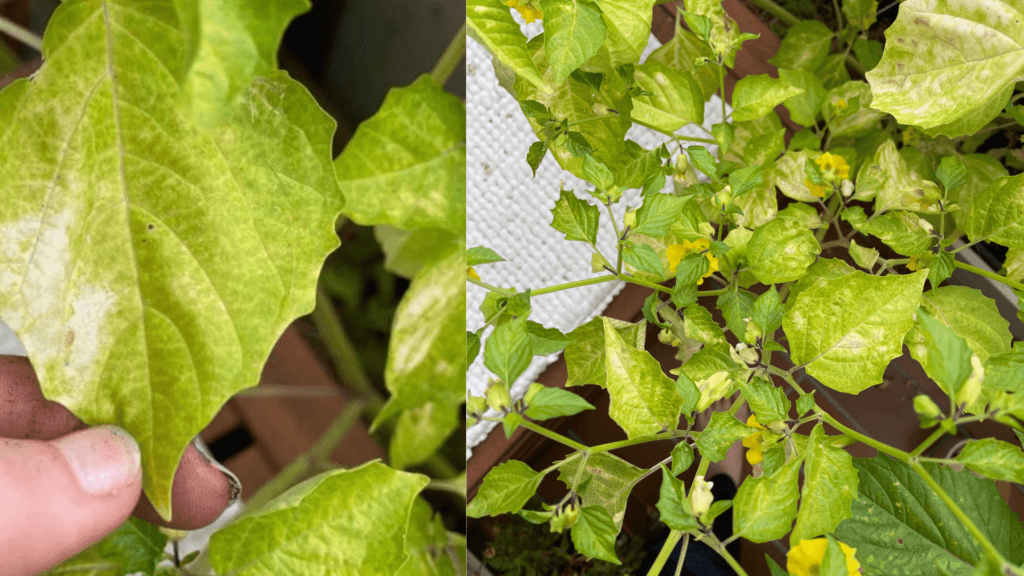This is a common question asked by gardeners who are growing these delicious fruits. Tomatillos, also known as Mexican husk tomatoes, are a staple in many Mexican dishes and have become increasingly popular in home gardens.
Like any plant, they can encounter issues that may cause their leaves to turn yellow.

Common Causes of Tomatillo Leaves Turning Yellow
There are several factors that can contribute to the yellowing of tomatillo leaves. It is essential to identify the cause in order to take appropriate action and ensure the health of your plants. Some common reasons include:
- Lack of water and sunlight
- Nutrient deficiencies
- Pests and diseases
- Over-watering and poor drainage
Let’s dive deeper into each of these causes and learn how to address them effectively.
Lack of Water and Sunlight for Tomatillos
Tomatillos, like most plants, require an adequate amount of water and sunlight to grow and produce fruit. If your tomatillo plants are not receiving enough of either, their leaves may start to turn yellow as a result.
Watering
To prevent this issue, ensure that your tomatillos receive consistent watering, especially during hot and dry periods. A general rule of thumb is to water your plants deeply once a week, allowing the soil to dry out slightly between waterings. However, you may need to adjust this frequency depending on your specific climate and soil conditions.
Sunlight
Tomatillos thrive in full sun, requiring at least 6-8 hours of direct sunlight each day. If your plants are not receiving enough sun, consider relocating them to a sunnier spot in your garden or adjusting nearby structures that may be casting shade on your plants.
Nutrient Deficiency, Including Magnesium Deficiency
Another common cause of yellowing leaves in tomatillos is nutrient deficiency. Plants require a variety of nutrients to grow and produce fruit, and a lack of any one of these can lead to yellowing leaves and other issues.
Magnesium Deficiency
One nutrient that is particularly important for tomatillos is magnesium. A magnesium deficiency can cause the leaves of your plants to turn yellow, starting with the older leaves and progressing to the younger ones. To remedy this issue, you can apply a magnesium-rich fertilizer or supplement, such as Epsom salt, to your soil. Simply dissolve 1-2 tablespoons of Epsom salt in a gallon of water and apply it to the base of your plants once every 2-4 weeks.
Other Nutrient Deficiencies
In addition to magnesium, tomatillos also require adequate amounts of nitrogen, phosphorus, potassium, and other micronutrients. If you suspect that your plants are suffering from a nutrient deficiency, consider having your soil tested to determine which nutrients are lacking. Based on the results, you can then amend your soil with the appropriate fertilizers or supplements to ensure your tomatillos receive the nutrients they need to thrive.
Fusarium Wilt: A Damaging Disease for Tomatillos
One possible reason could be Fusarium wilt, a soil-borne fungal disease that can infect tomatillos and cause their leaves to turn yellow. This disease is caused by the fungus Fusarium oxysporum, which can persist in the soil for several years. Infected plants may exhibit yellowing leaves, wilting, and stunted growth.
To manage Fusarium wilt, it is essential to practice good garden hygiene and crop rotation. Avoid planting tomatillos in the same spot year after year, as this can increase the risk of disease buildup in the soil. Additionally, removing and destroying infected plants can help prevent the spread of the fungus to healthy plants.
Pests That Cause Foliage to Turn Yellow and Dry
Pests can also be a culprit behind yellowing tomatillo leaves. Some common pests that can cause damage to tomatillo plants include:
- Aphids
- Whiteflies
- Spider mites
These pests feed on the sap of the plant, causing the leaves to turn yellow and dry up. If left unchecked, they can severely damage or even kill your tomatillo plants.
To control these pests, consider using insecticidal soap or neem oil as a natural, eco-friendly solution. Additionally, introducing beneficial insects, such as ladybugs and lacewings, can help keep pest populations in check.
Solutions for Fixing Yellowing Tomatillo Leaves
If you have identified the cause of your tomatillo leaves turning yellow, there are several steps you can take to remedy the issue and ensure the health of your plants:
- Watering: Ensure your plants receive consistent, deep watering, allowing the soil to dry slightly between waterings.
- Sunlight: Provide at least 6-8 hours of direct sunlight daily for optimal growth.
- Nutrient management: Test your soil and amend with the appropriate fertilizers or supplements to address any nutrient deficiencies.
- Disease control: Practice good garden hygiene and crop rotation to prevent the buildup and spread of soil-borne diseases like Fusarium wilt.
- Pest management: Use eco-friendly solutions like insecticidal soap, neem oil, and beneficial insects to control damaging pests.
Educating Readers About Tomatillos’ Fertilization Frequency
Proper fertilization is crucial for the health and productivity of your tomatillo plants. However, over-fertilization can cause its own set of problems, including yellowing leaves. It is essential to strike a balance between providing the necessary nutrients and avoiding over-fertilization.
As a general guideline, tomatillo plants should be fertilized at planting time and then again when they begin to set fruit. A balanced, slow-release fertilizer, such as a 10-10-10 formula, is typically recommended. However, it is always best to test your soil and follow the recommendations based on the specific nutrient needs of your plants.
Conclusion: Understanding the Reasons Behind Your Yellowing Tomatillos
There are several factors that can cause your tomatillo leaves to turn yellow, including lack of water and sunlight, nutrient deficiencies, pests, diseases, and over-fertilization. By identifying the root cause and taking the appropriate steps to address the issue, you can ensure the health and productivity of your tomatillo plants.
Remember to practice good garden hygiene, provide consistent water and sunlight, and manage nutrients and pests effectively. With proper care, your tomatillos will thrive and produce a bountiful harvest for you to enjoy.
